Leather Working Hammer - Cobblers Hammer
I have been using this CS Osborne leather working hammer in our shop since the 1970s. The metal head is painted black which is the way C.S. Osborne in USA used to make the Cobblers Hammers. However now they do not paint the shoe hammer heads.
These hammers are used daily by many artisans for leatherwork, shoe repair and shoe making. These leather hammers are often referred interchangeably as a cobblers hammer, shoe hammer, or leatherwork hammer although they all have similar uses.

Jamie holding his well used CS Osborne leather working hammer.
In the picture below, all the hammers have an outward curvature on the face to prevent the face edge from marking the leather. The leather working hammer shown on the left is made by C.S. Osborne in USA who has been making quality tools for the leather industry since 1826. This shoe hammer on the right is also made by C.S. Osborne.
In the middle is a leatherworking hammer made by a well know leather tool manufacturer called Ivan. This style is often referred to as a french hammer. You can see the longer neck which allows you to reach inside an item as well as the gentle sloping curvature of the back half of the hammer which is characteristic of this french shoe hammer style.
The back end on these two C.S. Osborne hammers is quite straight while the Ivan hammer is more rounded.
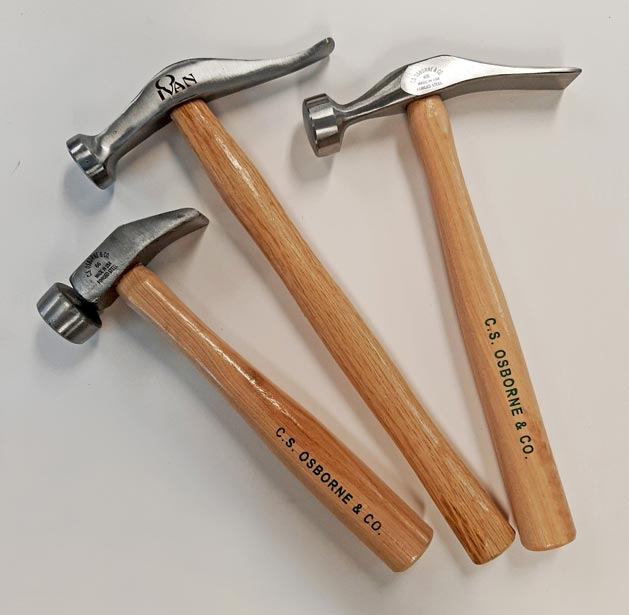
CS Osborne leather working hammer (left) and shoe hammer (right), Ivan leatherwork hammer (middle).
Leather Working Hammer Bonds Contact Cement
The leather working hammer is ideal for adhering two pieces of leather that have had contact cement applied. Contact cement is applied to both leather surfaces. When no longer tacky, the two leather pieces are pushed together and hammered with a leather hammer on an anvil to form a strong bond.
The convex shape of the hammer face prevents it from marring the leather when striking the leather. Because of this outward curvature, the round hammer face is also often used for shaping the leather around a shoe last.

C.S. Osborne leather working hammer used to bond two pieces of cemented leather together on shoe anvil.
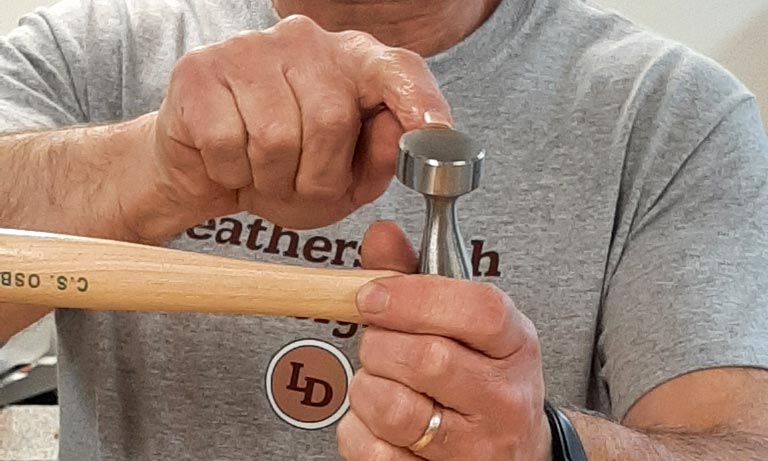
The face of this C.S. Osborne shoe hammer is curved outward to prevent the edge from marking the leather.
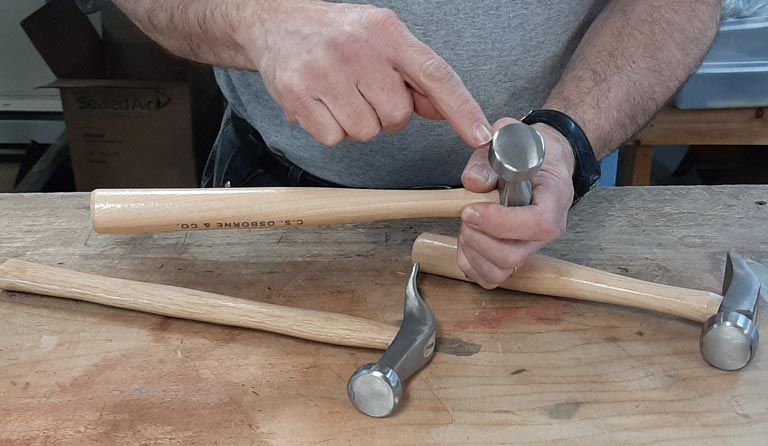
All these leather working hammer faces are not flat but are convex shaped to prevent the leather from being marred.
Shoe Hammer Sets Rapid Rivets
The leatherworking hammer can be used to set single or double cap leather rivets. Simply make a hole with your leather hole punch and then insert your rivet post and cap. Place it on a mini anvil or other metal object and tap it with your leatherwork hammer to set your rapid rivet. It gives a flat industrial look to the rivet.
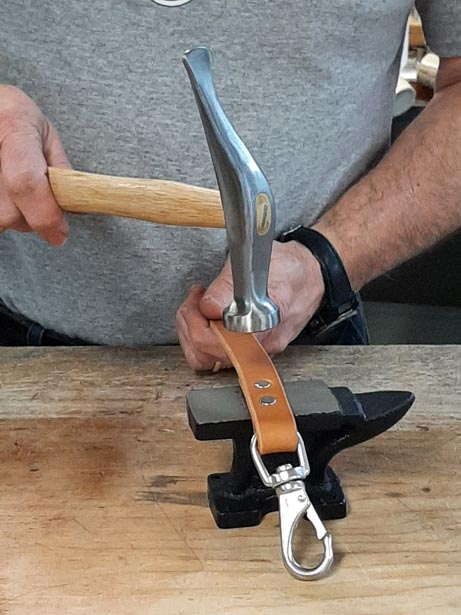
Ivan leatherwork hammer setting rapid rivets in leather on mini anvil.
Leatherwork Hammer Flattens Lace, Thread and Folds
In our leather shop, we use the round end of the leatherwork hammer to tap the leather to form tight folds, for flattening lacing, and for flattening stitching. The leather for the coin purse below was first soaked in water before tapping the folds tight.

Ivan leatherwork hammer taps coin purse to make tight folds in the leather.
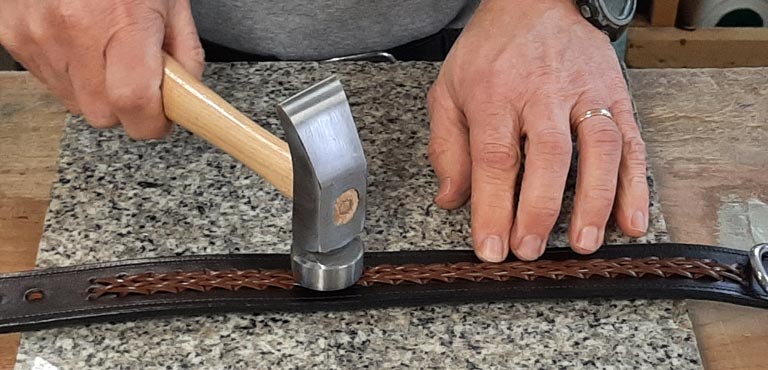
C.S. Osborne leather working hammer flattens leather lace weave on dog collar.
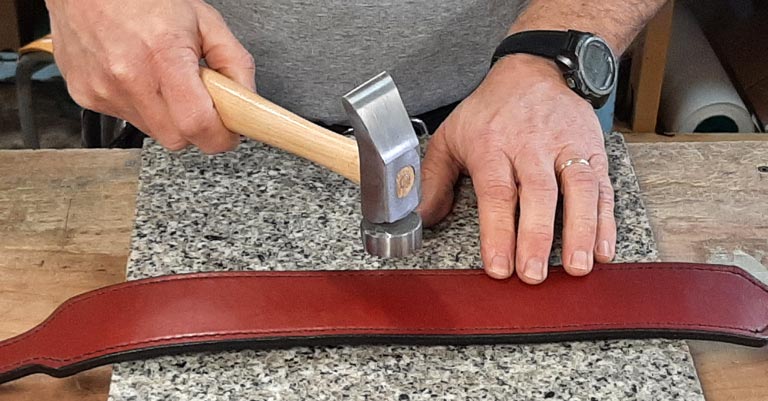
C.S. Osborne leather working hammer flattens harness thread on dog collar.
Cobbler's Hammer Back End Purpose
The back end of the shoe hammer which is thinner and straighter is often used in shoe making and shoe repair for peening or compacting the leather layers of the sole and heel to form one blended surface. The back end is often used for getting the heel nails deeper and can also be used for smoothing leather. Additionally, the back end is often used to hammer down seams such as where the leather half sole is spliced onto the shoe.

The CS Osborne leather working hammer (right) and shoe hammer (middle) have a wider flat back end.

The Ivan leatherwork hammer (left) has a curved narrower back end.
Best Hammer For Leather Working
Any of these hammers are a smart choice to use in your leather shop as their functions are all remarkably similar. Every leather shop, shoe repair shop or shoe maker could not do their trade without one of these essential hammers among their leather tools. If budget is a consideration, the Ivan leatherwork hammer may be a better choice as it tends to be less expensive than the C.S. Osborne hammers even though it is still excellent quality.
However, keep in mind if you are striking setter tools or leather stamps, you should not strike a metal hammer on your metal leather tools as it could cause your tools to start mushrooming. If your tool starts to mushroom, a piece of metal could break or fly off which would not be safe. For these applications you should use a rawhide mallet, wooden mallet, poly head mallet or bakelite mallet to make your leathercraft tools last longer. For applications that require more force, use a heavier leathercraft mallet.
View our large selection of leather hammers and leathercraft mallets supplied that would be beneficial for your leather shop.
Video of Leather Hammers Discussed And Demonstrated








